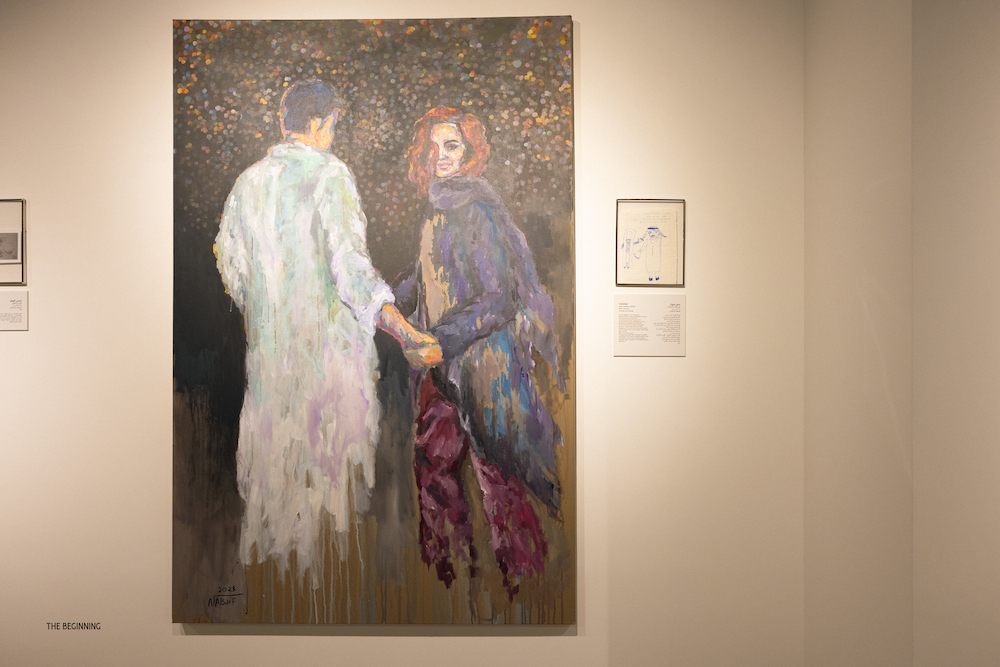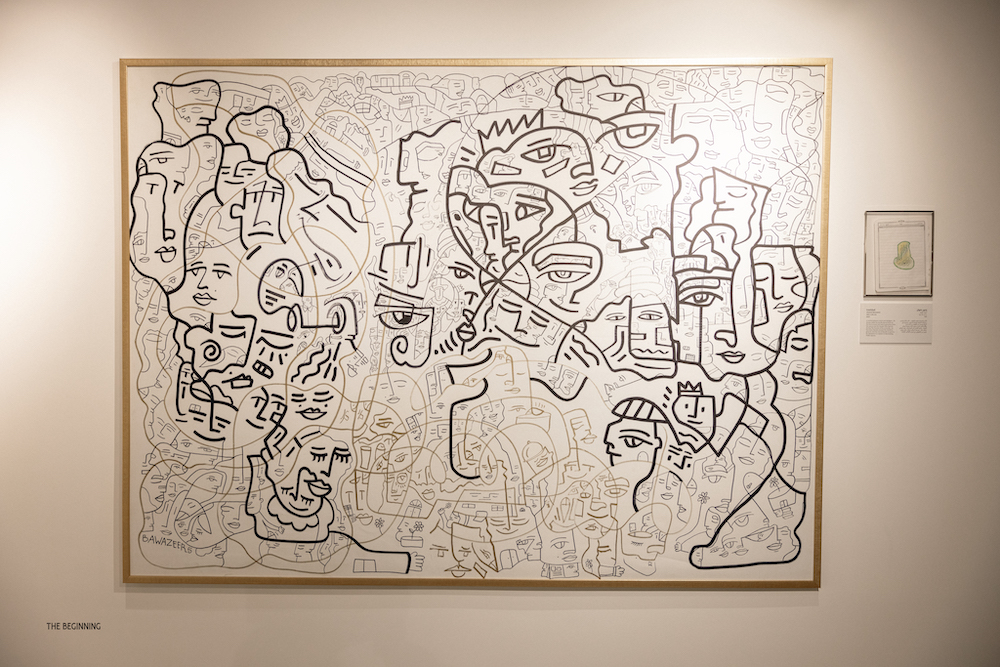RIYADH: While Saudi Arabia marks its beginnings as a nation 300 years ago through Founding Day celebrations, artists in the Kingdom are looking back on their own history through an exhibition aptly titled “The Beginning.”
The exhibition, the creative hub Burble’s second original event, was launched on Feb.19 with a diverse lineup of artists chosen by arts and events curator Dana Qabbani.
Eight artworks on display until Feb. 24 offer a retrospective experience of each artist.
“We wanted to take the exact moment where each individual realized they wanted to be an artist and felt like they wanted to do this, displayed literally on paper in front of you,” Qabbani told Arab News.
Prince Mohammed bin Bandar, founder of Burble, said: “For everything, there is a beginning, including the Kingdom. The idea was to showcase the beginnings of each artist. ‘Vol. 2’ was our opening art exhibition in January, and people would ask me: ‘When was Vol. 1?’ It was 100 years ago, I would say.
“Saudi Arabia has gone through two social events that changed the fabric of this country completely in the past 100 years. The first was King Abdulaziz’s unification of the Kingdom. Almost 100 years after that came Crown Prince Mohammed bin Salman’s Vision,” he said.
Like Vision 2030, the exhibition targets a wide range of social and community concerns, addressing the nuances of a changing region through digital art, pencil drawing, photography and acrylic paintings.

Writer and artist Noor Alsaif uniquely captures the simplicity of everyday moments in movie-like scenes. Her message is subtle but strong: What was once a Saudi that encouraged women to follow, now encourages them to lead.
Artists Awatef Al-Safwan, Taghreed Baghsi, Noor Hisham Alsaif, Fatimah Al-Hakami, Faisal Bin Zarah, Ahmed Bawazeer, Eman Ghuffah and Eligatou take the audience on a nostalgic journey from the time their first pencil brush transformed a blank page, for example, to their most notable works today.
Al-Safwan’s “Our Sand Our Heritage” explores the depths of Saudi culture, with sections painted using sand from her hometown, Tarot Island. The artwork was created using the Indonesian batik technique and is showcased alongside her first experiments with the method in 1992.
Scriptwriter and artist Alsaif captures the simplicity of everyday moments in movie-like scenes. Her first drawing is recreated in impressionist style: In her grandfather’s house, she draws guests who are arriving and leaving.
Qabbani also wanted to pay tribute to the work of Ghuffah, an artist who died at the age of 15, only months before the exhibition.
Ghuffah’s early sketches, drawn when she was 8, were of the cartoon characters Power Puff Girls, but her growing skill is evident in a mature depiction of King Abdulaziz sitting in distinction against a golden backdrop.
“I see how great she was as an artist, and I hope it touches someone,” Qabbani said.

Qabbani was also determined to pay tribute to the work of young artist Eman Ghuffah, who passed away only a few months prior to the exhibition. Fifteen-year-old Ghuffah grew up with special needs, but had a certain talent and passion for art.
The exhibition also creates space for non-Saudis who call the country home. Multidisciplinary artist Bawazeer’s work takes art from the street to a gallery. Inspired by Riyadh, where he was born and raised, it sets out to humanize the city by depicting it through the faces of passers-by seen during his time painting murals around the capital.
“You can’t deny that they are here. There are people living here that would die for this country, not just love it. So I felt that we had to push to have at least one artist (included in the exhibition),” Qabbani said.
Saudi Arabia’s potential has only recently been shown to the world, as the country positions itself as a leading entity globally in various sectors. However, not long ago, its presence in the world was a shadow to other nations.
In parallel, Qabbani’s curatorial venture does more than shed light on history. Rather, it salutes the unsung art heroes whose potential was never fully displayed to the world.

The exhibition also creates space for non-Saudis who call the country home. Multidisciplinary artist Ahmed Bawazeer’s work takes art from the street to a gallery, inspired by the city he was born and raised in: Riyadh. It humanizes the city by depicting it through the faces of passers-by during his time painting murals all over the city.
“In Saudi, specifically in contemporary art, there’s no middle ground. We’re either with the immensely popular artists or support really young and emerging artists.
“For the artists in this art space today, the selection process consisted of asking, ‘who is authentic, original, and has worked hard as an artist, but never got their chance or recognition that they deserve?’” Qabbani said.
She hopes the gallery will inspire emerging and young artists, and that seeing the evolution of each exhibitor’s work, they, too, will scale new heights with their own practice.














